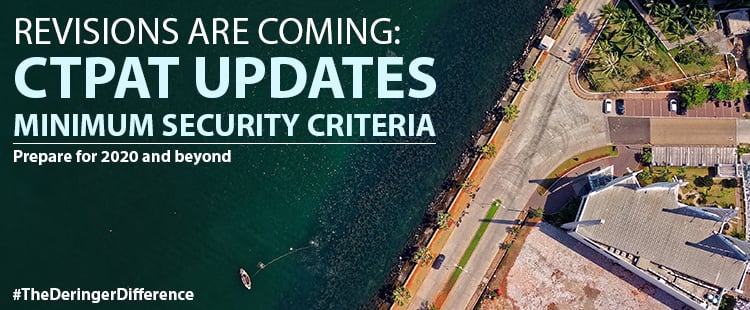
In today’s working environment, the U.S. Customs and Border Protection (CBP) supply chain security program CTPAT (
The most significant benefit for an organization to be
CTPAT Minimum Security Criteria (MSC) proposed updates, which were published earlier this year, will have a direct impact on each CTPAT partner’s supply chain security program.
With Customs’ shift from Supply Chain Security to one that includes trade compliance, the CTPAT Security & Trade Compliance program incorporates the Trusted Trader Strategy, taking a tiered approach that includes an increase in tangible partner benefits as an organization works to be compliant at each program level; including Security, Import Compliance, Partnership, and Global Reach. With these changes come new benefits, so it is worthwhile to read all of the available documentation, and feel free to discuss with us what this could mean for your company.
CTPAT Trade Compliance: Trusted Trader Strategy
CTPAT Trade Compliance is designed to focus on both International Supply Chain Security and Trade Compliance, ultimately meeting the globally recognized AEO (Authorized Economic Operator) standards.
The program requires a commitment to security, compliance, and partnership between the trade and regulatory government partners throughout the global supply chain.
CBP’s goal is to provide achievable, tangible benefits for all organizations who participate in the CTPAT supply chain security program.
What does this mean for organizations who are already CTPAT members?
The referenced timeline indicates that CBP will develop and provide training on the final program requirements by January 2020, with implementation starting in February 2020. To prepare for these changes, however, CBP has made available the proposed Minimum Security Criteria (MSC) updates, by business entity type.
Building on the CTPAT program, which was implemented after the 9/11 attacks, and realizing that the current global trade environment faces ever-evolving threats and challenges, CBP has proposed updates to the MSC that take into consideration:
- Legal Mandates
- CBP’s Mission
- Acknowledge the Changing Trade Landscape
- CTPAT’s Accumulated Experience
- Level of Terrorism & Criminal Activity

Categories for MSC Guidelines
You can find a full list of the proposed Importer MSC guidelines here.
Corporate Security | Transportation Security | People & Physical Security
Next Steps:
FIRST: Every organization must review the CTPAT Security & Trade Compliance program benefits, as well as the requirements at each of the defined levels of the Trusted Trader program. Then, at a corporate level, determine where the organization wants to be.
SECOND: Assess the CTPAT Security Program that is currently in place within your organization, and
THIRD: Initiate the development and implementation of any required program changes.
Corporate Security
Corporate Security is broken down into four categories, with two new categories added to the CTPAT MSC guidelines. These categories include Security Vision and Responsibility (new), Risk Assessment, Business Partner Security, and Cybersecurity (new).
- Security Vision & Responsibility (New)
Culture is a vital aspect of every business, and to ensure a robust supply-chain security plan, the security guidelines should be integrated within the company's values and everyday business processes. Upper management MUST be fully engaged with the development, implementation, and supervision of these programs at every level within the organization.
- Risk Assessment
Continued threats within the international supply chain force CTPAT members, and their partners, to remain sensitive to threats and dangers that exist. CTPAT members MUST conduct a risk assessment that evaluates the security processes and procedures that have been implemented and are being followed by each partner of their international supply chain.
- Business Partners
Screening business partners
- Cyber Security (New)
With the evolution of technology comes the need for tight security guidelines. Cybersecurity plays a crucial role in safeguarding a company's most precious assets and requires the organization to create policies and procedures that will be used to deter cyber attacks and safeguard information. Having a solid cybersecurity plan may also position an organization better with business partners, customers, investors, and other stakeholders.
Transportation Security
Transportation security focuses on the physical movement and handling of goods throughout the supply chain. The four criteria include Conveyance and Instruments of International Traffic Security, Seal Security, Procedural Security, and Agricultural Security.
- Conveyance and Instruments of International Traffic Security
Members must have processes and procedures in place to prevent, detect, or deter un-manifested material and/or unauthorized personnel from gaining access to conveyances and Instruments of International Traffic (IIT) at every stage of the supply chain.
- Seal Security
A critical element to ensure a secure supply chain is the sealing of trailers and containers. This component includes continuous seal integrity. These policies have been further developed, requiring Members to have a comprehensive seal policy, addressing all aspect of seal security.
- Procedural Security
Documented security procedures must be in place to ensure the integrity and security processes relevant to transportation, handling, and storage of cargo at every stage in the supply chain. This category has been expanded to include procedures that address security audits and the staging and loading of cargo.
- Agricultural Security (New)
As the most significant industry and employment sector in the United States, agricultural security is a new, yet crucial element to the MSC updates. Foreign animal and plant contaminants such as soil, manure, seeds, and plant and animal material may harbor invasive and destructive pests and diseases. Documented procedures must be in place that will eliminate contaminants from all conveyances and types of cargo, ultimately reducing cargo delays and/or returns.
People & Physical Security
The securing of facilities, screening of employees and business partners, and training of personnel are all critical components of any organization’s successful security program. The four sub-categories within this section include Physical Security, Physical Access Control, Personnel Security, and Education, Training & Awareness.
- Physical Security
Partners MUST have documented procedures in place that are designed to prevent, detect, and deter unauthorized individuals from cargo handling and storage facilities throughout the supply chain.
- Physical Access Control
Access controls prevent unauthorized entry to facilities, maintain control of employees and visitors, and protect company assets. Access controls MUST include the positive identification of all employees, visitors, and vendors at all points of entry at the facility.
- Personnel Security
A company's human resource force is a critical security asset; however, if not adequately secured, it can be a weak link. MSC requires employee screening, pre-employment verification, background checks, and the issuance of access devices and termination procedures.
- Education, Training & Awareness
Remember
CBP is working to develop and provide training on the final program requirements by January 2020, with implementation starting in February 2020. In preparation for the anticipated changes, we would like to take this opportunity to understand what your goals are - as they relate to the CTPAT Security & Trade Compliance program. It is worthwhile to review the new benefits and opportunities available through participation at varying levels, and Deringer is ready to work with you to develop and implement updates that will position your organization for success.






